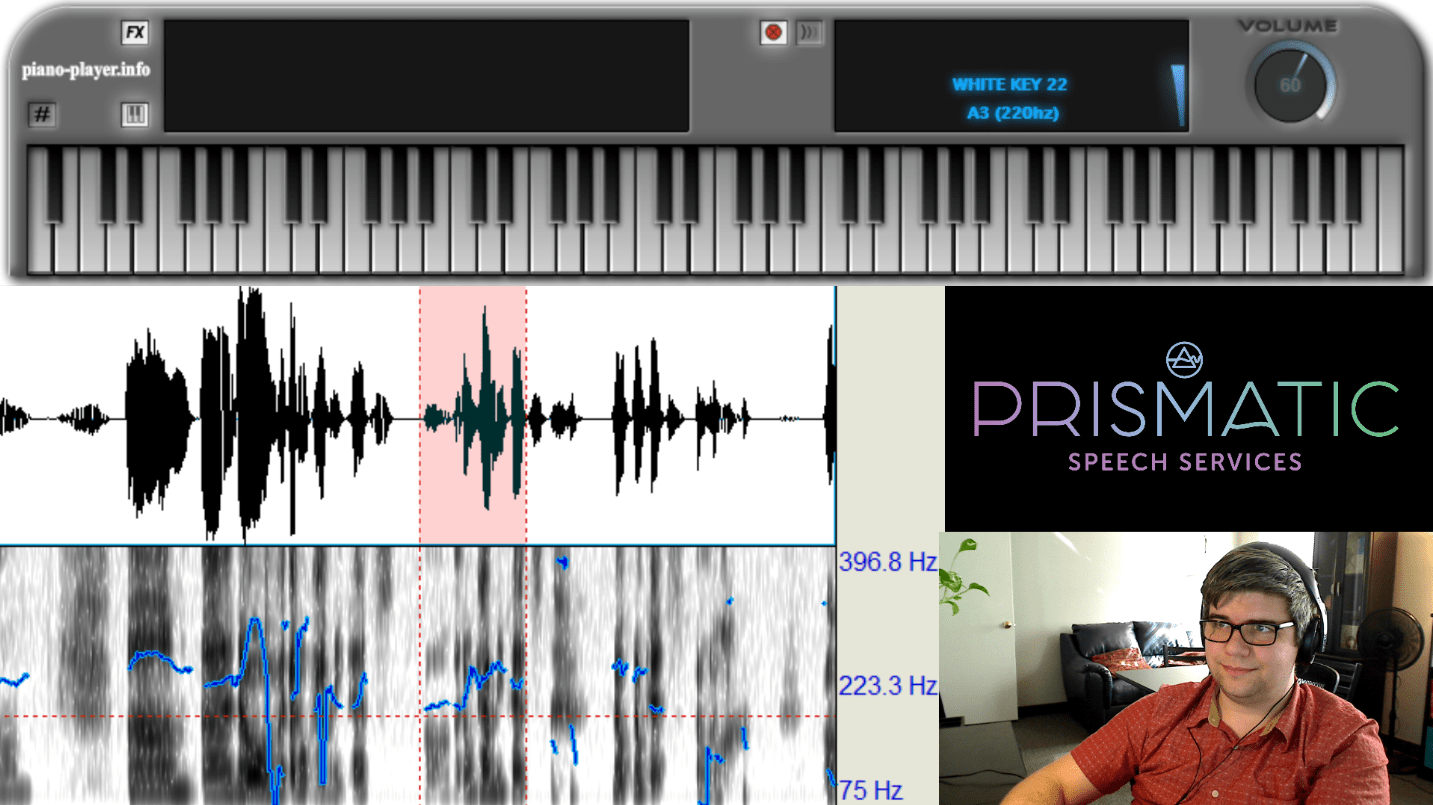Telepractice: Long-Distance Speech Services

All Clients Deserve Quality Services
When it comes to seeking specialty services, such as voice therapy, finding a quality provider nearby can be a challenge. When trying to find clinics which have subspecialties like transgender vocal training, it can be near impossible. Most clinicians who specialize in these services tend to cluster around larger cities, where a more reliable stream of clients can be expected. As a result, there are many barriers to accessing these services for countless people across the United States. Proximity to specialty clinics, travel time and expenses, and lost income due to travel cutting into the client's workday can all prevent a client from seeking the services which could greatly improve their quality of life. When the cost of seeking these services are added up, the drawbacks outweigh the benefits for many.
This hardly seems fair for the client. They should not have to resort to a lower quality of life simply because of their location, particularly in the digital age. Thankfully, medicine is a field which never ceases to innovate and look for new ways to integrate the technology in our society to provide higher quality services for a wider scope of people.
Table of Contents
What is Telepractice?
Frequently Asked Questions
What States are you Licensed in?
Are Telepractice Sessions as Effective as In-Person Sessions?
What Technology do I Need?
How is Payment Managed?
I'm Worried About Confidentiality and the Safety of My Protected Health Information (PHI).
Speech-Language Pathology Telepractice Research
What is Telepractice?

More broadly known as telemedicine or telehealth, telepractice refers to the integration of telecommunications technology with the delivery of speech-language pathology or audiology services. Using this technology, clinicians such as myself can work from their office and meet with clients in their home or office–anywhere that is comfortable, private, and has a stable internet connection. This way, clients can access healthcare remotely, removing distance and mobility as barriers for many.
Delivery Method
There are several different ways services can be delivered via telepractice; Prismatic Speech Services uses two-way video conferencing software, Zoom, as well as several other applications and resources to deliver stellar services to residents of Virginia, North Carolina, South Carolina, and Georgia. Sessions held on Zoom are accessible via smartphone, tablet, or computer, and accessing them doesn't involve exchanging identifying information; all a client needs to do to join the session is click the unique URL shortly before their session, and they'll be connected directly to their clinician!
Frequently Asked Questions
What States are you Licensed in?
I am currently licensed to work with anyone who has a permanent residence in Virginia, North Carolina, South Carolina, and Georgia.
Are Telepractice Sessions as Effective as In-Person Sessions?
There is an ever-growing library of research showing that telepractice is as effective as in-person sessions. For speech-language-pathology-specific research, see the bottom of this article.
What Are the technical Requirements for Telepractice?
In order to participate in telepractice sessions with Prismatic Speech Services, we require that the client have the following items:
- A stable internet connection (at least 600 kbps upload and download speed; test your internet connection here)
- A computer with webcam, or a smartphone with a camera
- A pair of headphones or earbuds
- A microphone of decent quality (headsets with microphones are often affordable and available at Target and similar stores)
How is Payment Managed?
Telepractice-based clients receive an invoice via email before their scheduled session. The client can pay the invoice via card or bank transfer. Clients are required to pay the invoice before the session can begin. If they cannot pay within 15 minutes of the start of the session, the session will be rescheduled and the client will be charged.
I'm Worried About Confidentiality and the Safety of My Protected Health Information (PHI).
Not to fear! Here at Prismatic Speech Services, we voluntarily comply with all ethical standards of the Health Insurance Portability and Accountability Act of 1996 (HIPAA), the Health Information Technology for Economic and Clinical Health Act of 2009 (HITECH), the American Speech-Language-Hearing Association (ASHA), and the World Professional Association of Transgender Health (WPATH). We take all necessary steps to protect you and your information, including using confidential video conferencing software, Zoom.
Speech-Language Pathology Telepractice Research
Aphasia
Macoir, J., Martel Sauvageau, V., Boissy, P., Tousignant, M., & Tousignant, M. (2017, January 23). In-home synchronous telespeech therapy to improve functional communication in chronic poststroke aphasia: Results from a quasi-experimental study. Telemedicine and e-Health. Advance online publication. doi:10.1089/tmj.2016.0235
Articulation Disorders
Crutchley, S., Dudley, W., & Campbell, M. (2010). Articulation assessment through videoconferencing: A pilot study. Communications of Global Information Technology, 2, 12–23.
Grogan-Johnson, S., Schmidt, A., Schenker, Alvares, R., Rowan, L., & Taylor, J. (2013). A comparison of speech sound intervention delivered by telepractice and side-by-side service delivery models. Communication Disorders Quarterly, 34, 210–220.
Autism-Related Delays
Higgins, W. J., Luczynski, K. C., Carroll, R. A., Fisher, W. W., & Mudford, O. C. (2017). Evaluation of a telehealth training package to remotely train staff to conduct a preference assessment. Journal of Applied Behavior Analysis, 50, 238–251.
Iacono, T., Dissanayake, C., Trembath, D., Hurdy, K., Erickson, S., & Spong, J. (2016). Family and practitioner perspectives on telehealth for services to young children with autism. Studies in Health Technology and Informatics, 231, 63–73.
Parmanto, B., Pulantara, W., Schutte, J., Saptono, A., & McCue, M. (2013). An integrated telehealth system for remote administration of an adult autism assessment. Telemedicine and e-Health, 19, 88–94.
Dysarthria
Hill, A. J., Theodoros, D. G., Russell, T. G., Cahill, L. M., Ward, E. C., & Clark, K. M. (2006). An Internet-based telerehabilitation system for the assessment of motor speech disorders: A pilot study. American Journal of Speech-Language Pathology, 15, 45–56.
Dysphagia
Cassel, S. (2016). Case reports: Trial dysphagia interventions conducted via telehealth. International Journal of Telerehabilitation, 8, 71–76.
Malandraki, G. A., McCullough, G., He, X., McWeeny, E., & Perlman, A. L. (2011). Teledynamic evaluation of oropharyngeal swallowing. Journal of Speech, Language, and Hearing Research, 54, 497–1505.
Perlman, A. L., & Witthawaskul, W. (2002). Real-time remote telefluoroscopic assessment of patients with dysphagia. Dysphagia, 17, 162–167.
Fluency Disorders
Carey, B., O’Brian, S., Lowe, R., & Onslow, M. (2014). Webcam delivery of the Camperdown Program for adolescents who stutter: A phase II trial. Language, Speech, and Hearing Services in Schools, 45, 314–324.
Carey, B., O’Brian, S., Onslow, M., Packman, A., & Menzies, R. (2012). Webcam delivery of the Camperdown Program for adolescents who stutter: A phase I trial. Language, Speech, and Hearing Services in Schools, 43, 370–380.
Lewis, C., Packman, A., Onslow, M., Simpson, J., & Jones, M. (2008). A Phase II trial of telehealth delivery of the Lidcombe Program of Early Stuttering Intervention. American Journal of Speech-Language Pathology, 17, 139–149.
Language and Cognitive Disorders
Brennan, D. M., Georgeadis, A. C., Baron, C. R., & Barker, L. M. (2004). The effect of videoconference-based telerehab on story retelling performance by brain injured subjects and its implication for remote speech-language therapy. Telemedicine Journal and e-Health, 10, 147–154.
Sutherland, R., Hodge, A., Trembath, D., Drevensek, S., & Roberts, J. (2016, September). Overcoming barriers to using telehealth for standardized language assessments. Perspectives of the ASHA Special Interest Groups, 1(SIG 18), 41–50.
Waite, M., Theodoros, D., Russell, T., & Cahill, L. (2010). Internet-based telehealth assessment of language using the CELF-4. Language, Speech, and Hearing Services in Schools, 41, 445–448.
Neurodevelopmental Disabilities
Simacek, J., Dimian, A., & McComas, J. (2017). Communication intervention for young children with severe neurodevelopmental disabilities via telehealth. Journal of Autism and Developmental Disorders, 47, 744–767.
Transgender Vocal Training
Pickering, J. (2016, November). Applying telepractice to improve voice and communication for people in the transgender community. 2016 ASHA Annual Convention, Philadelphia, PA.
Voice Disorders
Halpern, A. E., Ramig, L. O., Matos, C. E. C., Petska-Cable, J. A., Spielman, J. L., . . . McFarland, D. H. (2012). Innovative technology for the assisted delivery of intensive voice treatment (LSVT®LOUD) for Parkinson disease. American Journal of Speech-Language Pathology, 21, 354–367.
Mashima, P., & Brown, J. (2011). Remote management of voice and swallowing disorders. Otolaryngologic Clinics of North America, 44,1305–1316.
Theodoros, D. G., Constantinescu, G., Russell, T. G., Ward, E. C., Wilson, S. J., & Wootton, R. (2006). Treating the speech disorder in Parkinson’s disease online. Journal of Telemedicine and Telecare, 12, 88–91.
Tindall, L. R., Huebner, R. A., Stemple, J. C., & Kleinert, H. L. (2008). Videophone-delivered voice therapy: A comparative analysis of outcomes to traditional delivery for adults with Parkinson’s disease. Telemedicine and e-Health, 14, 1070–1077.
Towey, M. (2012b). Speech therapy telepractice for vocal cord dysfunction (VCD): MaineCare (Medicaid) cost savings. International Journal of Telerehabilitation, 4, 34–36.
I hope that this article was educational for you; let me know if you have any questions and I'll be more than happy to answer them.
If you are interested in receiving services via telepractice, but you are not sure if your telecommunications setup is adequate, you are still encouraged to request a free consultation to test it out! Don't let that uncertainty hold you back from seeking services you think will improve your quality of life. If we determine that telepractice is not viable for you, I may still be able to refer you to a local clinician.
Best,

Leave a Comment
(0 Comments)